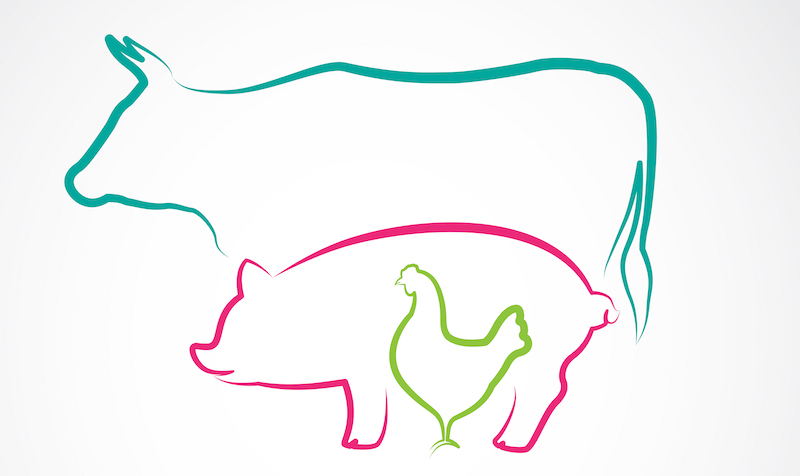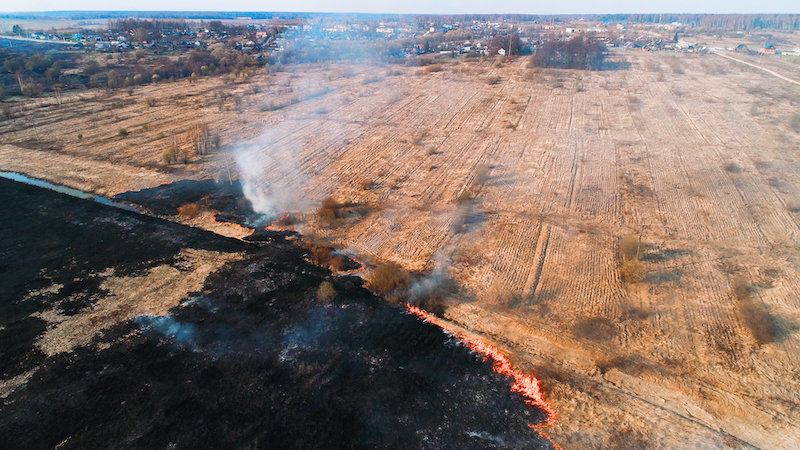Livestock in wildfires
July 2021: The year 2020 witnessed massive wildfires on a global scale, affecting rural areas and businesses, wildlife and livestock with devastating death tolls. Lyzi G Cota provides practical advice for such scenarios, including guidance on how to protect livestock and pets.
 Destructive fire can affect farm buildings, challenging the agricultural recovery and making it more complex owing to ash-covered farmland and drought risk. If located in rural areas, residents are the first responders when disasters strike. Farms are often in isolated areas, and fire, police and ambulance services might be delayed in their response. Image: yod67/123rf
Destructive fire can affect farm buildings, challenging the agricultural recovery and making it more complex owing to ash-covered farmland and drought risk. If located in rural areas, residents are the first responders when disasters strike. Farms are often in isolated areas, and fire, police and ambulance services might be delayed in their response. Image: yod67/123rf
What follows are recommendations offered by Emergency Management Australia in conjunction with the Australasian Fire Authorities Council and Country Fire Authority, the US Federal Emergency Management Agency (FEMA), Natural Resources Defense Council, US Air Quality Index and the National Ag Safety Database (NASD).
Prevention and mitigation
This is not an exhaustive list. First, avoid smoking in the forest or in barns and implement and enforce no-smoking policies on property. Use only fire-resistant materials on the exterior of barns and homes. Mow grass frequently, removing leaves and weeds, trimming bushes and trees. In high-risk areas, it is worth considering replacing grass for non-flammable ground cover like pebbles, especially around building perimeters. Try to keep garden beds moist and make use of fire-resistant plants, such as aloes and hedging roses and opt for less flammable tress like maple, cherry and poplar rather than conifers and pines. Ensure that leaves are cleared from roofs, downpipes, gutters and around the base of trees and, to ensure compliance with local water restrictions, maintain a well-watered lawn. On a working farm, store combustible materials away from where animals are housed; especially during summer because they can undergo spontaneous combustion in the heat.
Ensure that all personnel working with animals are instructed about the use of fire extinguishers, their location and conduct fire drills monthly during fire season.
In terms of the local surroundings, monitor local radio and television for warnings about local fire conditions and enquire with the local fire department about the minimum distance for a fire break, based on types of trees, the surrounding landscape and the construction of buildings. Learn to recognise dangerous fire conditions and consult with the fire department on how to improve the safety of your house and barns.
If officials evacuate the area, leave immediately. House pets should be leashed or crated and taken with you.
All animals that are exposed to fire should be monitored for smoke inhalation pneumonia, the most common cause of fire-related death. Also, make sure to consult a veterinarian for any burn injuries.
It is worth taking the time to prepare an evacuation plan for livestock and confirm plans with the local community as well. First aid kits and fire extinguishers should be checked, maintained regularly and kept in easily accessible places. If livestock and poultry are likely to need evacuation at some point, consider building a small safety room made from bricks that they can be moved temporarily.
Create a personal protection kit: Cotton and wool clothes are essential; a long-sleeved shirt with non-rolling sleeves; goggles; loose-fitting cotton trousers; resistant leather gloves; a wide-wing hat; and leather boots with a good tread band. Synthetics melt, causing severe burns, so avoid tennis shoes, rubber boots or synthetic footwear.
Making notes
In preparation for wildfires and in the case of having to move or relocate animals, ensure that they have permanent identification, such as tattoos, ear tags, brands or electronic microchips. Save up-to-date pictures, especially if they are high-value animals, such as horses. Compile a list of animal species, number and location and keep it with evacuation supplies. Identify animals’ hiding spots if they tend to bolt and make a written note or take a photo of them. Store medical records, vaccination records and registration papers in an evacuation kit (see below). Keep tetanus vaccinations updated for livestock and make a record of when they were administered.
Evacuation preparedness
Time spent assembling an evacuation kit is well worth. Inquire about temporary shelter for livestock and research organisations’ policies. Identify trailer options and train livestock in being loaded. Prepare an evacuation plan for animals with different evacuation routes and check with local emergency management officials or authorities before you need to evacuate. For off-site movement of corral animals, do not wait until the last minute and ensure that personnel are trained to handle the move.
Evacuation kits
The Environmental Protection Agency (US EPA-452/F-19-001) makes the following recommendations for items to be included in an evacuation kit (consider animals’ specific needs):
-
Food, supplements and water supply for seven to ten days;
-
Blankets, leads, halters, ropes, heavy leather gloves;
-
Copies of vaccination records, medical records and proof of ownership;
-
Tools: flashlight, knife, wire cutters, manure fork, shovel, and trash barrel, water buckets;
-
Animal care instructions for diet and medications (for animals left at a shelter); and
-
Emergency cash, first aid kit, emergency contact list.
If animals must be left behind, there are several measures that can be implemented to keep them safe. Have a pre-selected, cleared area where animals can be relocated. Cut fences, open gates, or herd livestock into areas of minimum fire risk and let first responders and neighbours know to be on the lookout for your animals. Leave enough water and food available for at least two or three days, but avoid relying on automatic watering systems.
Protecting birds
Special considerations are needed for birds because they are highly sensitive to fumes and succumb to smoke quickly. Have enough carriers on hand or wheeled cages prepared and build bird cages with sufficient dome height to keep the perches away from the ground. If the birds’ environment depends on a continuous supply of power, install a generator. Fit nest boxes with a hinge-type cover over the entrance and quick-release latches to permit fast removal for their transportation. Aviaries can be equipped with an overhead sprinkler system to cool the air and reduce the risk of smoke inhalation and burn injuries. And if possible, consider relocating outdoor birds to a less smoky environment, like a garage or basement.
Protection for cattle and horses
Cattle and horses can easily be spooked so it is important to take precautions to ensure that their experience is as calm as possible. Horses can be panicked by sirens or a smoke-filled trailer and they might refuse to leave their building. Worse still, they might try run back into a burning building, so it is crucial to close barn and outbuilding doors.
In terms of preparing for the worst, there are several safeguards that can be implemented. Using leather halters or cotton rope for livestock is preferable to nylon halters, which melt when they heat up, potentially causing deep burn wounds. Similarly, during a fire, remove all synthetic materials from horses and stables, such as nylon caps, blankets, soaps and masks. It helps to place pieces of wet cloth around horses’ nostrils to reduce smoke inhalation, wet manes and tails, and if evacuation is advised, it may help to blindfold them. Handlers should wear firefighting clothing; get your horse familiar with their appearance to reduce their panic: A face mask, cotton swab, or 'Bandido-style' cloth can protect the nose and face from smoke effects for a short period; and glasses help to protect the eyes against smoke and burning embers.
For easy identification in case of cattle or horses going astray, ‘paint’ your name and phone number on them using grease crayons. For cattle, identification tags, collars and pegs in the chair can also be helpful.
If there are alternative places to temporarily move horses such as stables, racetracks, exhibition fields, fairgrounds or fenced parks, make sure they are available for use. If it is impossible to evacuate, place the horses in a safe area like an arena, a large dry lot, a grazed field without flammable materials such as trees, wooden poles or dry vegetation. Experience shows that most horses suffer minimal burns if given maximum space; they gallop through the flames around the edges to stop in previously blackened and burned areas until the fire is over.
Do not lock up the horses in stables or small patios and it is imperative never to release horses on the road as they can cause accidents for which you will be legally responsible.
 If animals must be left behind, there are several measures that can be implemented to keep them safe, such as having a pre-selected, cleared area where animals can be relocated. Image: nordroden/123rf
If animals must be left behind, there are several measures that can be implemented to keep them safe, such as having a pre-selected, cleared area where animals can be relocated. Image: nordroden/123rf
In response
If residents can stay in situ, the protection of livestock and poultry should be high up the agenda. Animals should be limited in the number of strenuous activities they do to minimise the amount of smoke in their respiratory system, and low-dust or dust-free feeds will also help to reduce dust exposure. Frequent misting and sprinkling of livestock holding areas with water will help keep animals cool; feeders, bathtubs, sinks, and metal buckets filled with reserve water for later use will ensure that supplies are maintained. Animals should never be tied to burned trees or buildings.
Without jeopardising the water supply and pressure for firefighters, dampen surfaces such as roofs. If evacuating, pets should be leashed or put safely in pet carriers and, if livestock cannot be taken, let them out of the barn and close all the doors to stop them running back into a burning barn if they get frightened.
Recovery
All animals exposed to fire must be monitored for smoke inhalation pneumonia and burn injuries must be treated by a veterinarian. Be cautious when re-entering burned areas because hot-spots could flare up without warning and partially burned structures or trees can be unstable and may suddenly fall over.
However, areas where animals are to be rehoused need to be inspected for dangerous debris before they are returned and animals should be kept away from areas where there may be ash pits, ie root systems that have burned underground. It is also important to clean pasture fences before any animals come into contact with them – galvanised metal heated during a fire may be coated with toxic residues.
Ask the local forestry commission for guidelines and when it is recommended to replant burned forests; this must be done quickly and efficiently to reduce soil erosion. Be aware that floods, landslides and mudflows can follow wildfires owing to vegetation damage.
Most importantly, consult with a veterinarian to give livestock four-to-six weeks for complete recovery from smoky conditions, before resuming strenuous activity that can damage their physical health and create unnecessary anxiety and exhaustion.